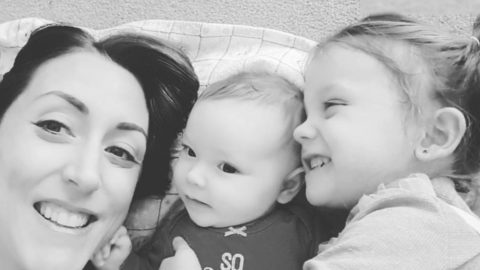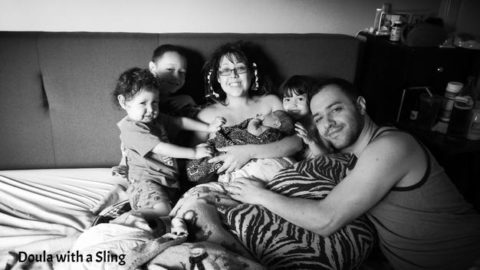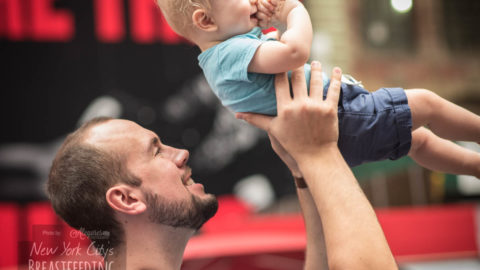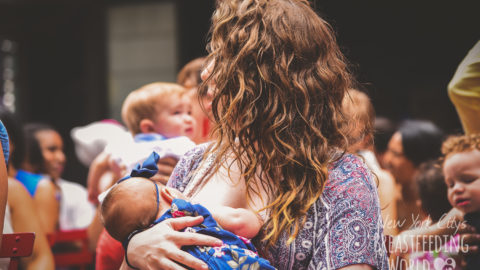An hour into pushing, I folded.
I had endured so much pain, aggravation, and exhaustion that I had lost sight of the prize. It was too much.
I can’t! I said to the room in general, I’ve got nothing left!
All around me, a half-dozen heads turned in my direction with sympathy on their faces; my husband withered, the nurse patted my hand, and the neonatologist team shook their heads as I visibly wilted. All heads, that is, except one. It popped up from its previously unwavering position at the foot of the hospital bed between where my feet were lodged intermittently in the stirrups: that head belonged to my certified nurse-midwife.
Are you kidding me? she practically shouted. After everything you went through to get here, to be able to do this… After all that, you’re not giving up now!
Less than ten minutes later, my third child was welcomed into the world, delivered safely into the hands of the only person who fought for what I wanted as hard as I did.
This is really the middle of the story, but it is the first moment of true glory in my constant battle to keep on a more natural path. And, every moment of doubt thereafter has been smacked down by a distinct voice with a distinct phrase.
This was my third pregnancy, so from the time we made the decision to have this baby; we knew what we were in for. I suffer from a condition that is only a part of my life during, what feels to be, the most important thing my body will ever go through.
It’s called Intrahepatic Cholestasis of Pregnancy or ICP, sometimes known as gestational cholestasis. For some reason, my body develops a block when trying to move bile salts between the gall bladder and the liver. The bile salts spill back into the blood stream, causing what is essentially, a pollution of the bloodstream. The medical community describes the feeling as “discomfort”, but anyone who suffers from the condition knows it is pure hell.
Itching breaks out on the palms of hands and soles of feet. It crawls up the arms and spreads through the body like poisonous insects crawling under the skin, stinging with every step. There is often no outward signs. No rash or discoloration, and scratching relieves nothing as the itch is under the skin. It becomes 24/7. Sleep is unattainable, warm weather makes it worse, creams and lotions can be useless. Approximately 1 in 1,000 women experience this misery. And, it often goes undiagnosed or misdiagnosed as an allergy.
I contended with it for weeks in my first pregnancy before my OB believed me enough to run the bile salts and liver enzyme on my blood test.
Treatment included, an oral medication for the itch, but the only cure is delivery of the baby. Delivery has to occur early, at or around 37 weeks gestation, because the biggest and scariest risk of the disease is stillbirth.
I thank my lucky stars that we caught it, and that my oldest son was delivered safely, even if he had a slew of complications. When we had my daughter, the prenatal care, and eventually the induction went much more smoothly than I could have imagined. We knew what to expect, yes, but I switched to a nurse midwife, and her care made all the difference. I was never doubted again, never made to feel ridiculous over my concerns. I was always encouraged, always informed of what my choices were. So, it was a natural decision three years later to go back to the same person when my next pregnancy test blinked a positive.
Baby number three was a surprise gender, and we were more financially sound and stable in our home than ever before. We expected a repeat of past issues, but knew we could certainly handle the fallout. I progressed beautifully and enjoyed more doting than ever from my husband, and I took my medications without a concern for itching.
Then, I broke out in a rash across my swollen belly early into the third trimester.
My midwife’s face was filled with sympathy when she saw the pox and the scratch marks, she knew it was PUPPP right away (Pruritic urticarial papules and plaques of pregnancy). She laughed when I started coming in with a belly wrapped in plastic wrap like a leftover meatloaf, but recognized the genius of how I kept the soothing lotion on. Still itchy, but I was determined to be in good spirits.
I saw her more frequently, and was going downstairs to the High Risk department for monitoring and biophysical profiles weekly. We were tracking progress as best we could, but of course everyone was still adamant about delivery at 37 weeks.
I’ve had expectant mothers with this condition, the high-risk OB would tell me, who came in and had perfect fluid, and heart rates, and the babies were moving around fine, and they would go home. Then I would get a call and an hour later, and the baby would be gone.
After hearing that, I was terrified.
I showed up at the hospital on the scheduled day, ready for my third medically necessary induction, nervous but excited. I was to be examined before they started the drip. “Uh oh”. That is not a phrase one wants to hear when under the scrutiny of anyone in the medical profession.
Your baby seems to have flipped, he or she is breech. Guess we’ll be having a C-section today! the hospital’s OB said brightly.
No, I refused.
I knew how important it was to get the baby out. I knew I wouldn’t be able to go home and come back another day. Sure, I had never gone into natural labor (not for lack of trying), but, being armed with knowledge of entirely too many statistics and facing the intense recovery of serious surgery, I balked.
The L&D doctors and nurses thought I was ridiculous; We can go in the OR and you can have that baby in your arms in a half hour, they said.
Still, I refused.
My midwife arrived, and offered me an alternative: external cephalic version, or simply a version. A trained doctor would push and roll the baby by placing pressure on my uterus from outside the body. It would be painful, so I would need anesthesia, and it had only about a 50% success rate.
I agreed. They had to me wait 4 hours, so the single bite of waffle I ingested that morning would be digested fully before the procedure. At 2:30 in the afternoon, I was administered the spinal/epidural combination, strapped to what looked like a cross, naked from the waist down in the OR with a team of doctors, students, nurses, and my husband. And, of course, my ever-present midwife. They pushed and rolled, and watched carefully on the ultrasound for signs of uterine rupture or distress from the baby. No one thought it would work at first, but they did it, to their own comical levels of surprise. They congratulated each other while my midwife soothed me.
She smiled, but she leaned towards me and said, Now the real work begins.
My legs were useless from the spinal, and the hospital nurses on the evening tour were adamant that I not move from my upright sitting position.
The baby needs to move down, to engage, my midwife explained kindly.
But of course, when she came back much later to find I hadn’t been allowed to move at all, that the overnight team had not provided proper sanitary care, wouldn’t allow me to remove the automatic blood pressure cuff for even a break, and that I was in immense pain with no sleep, I caught my first glimpse of her temper.
Twenty-three hours of labor. We were all at the end of our ropes.
I had not eaten since 6 AM the day before, I was not allowed even a sip of water. My husband was a champ, stroking my hair and speaking soothingly all day and night, jumping at any request. But, even his eyes were dim now, his five o’clock shadow grown into a full beard. He rotated his head to stretch his neck, never releasing my hand from his grasp. My lifeless leg dangled over his elbow. “You got this. You can do anything,” he whispered to me.
My midwife glared at me after her outburst. Then she softened. You can do this! Don’t you tell me you can’t, after all that. Now PUSH!
The pain was intense, they had turned the epidural down so low (at my request, so I could use my own muscles better) that I suspected it was turned off. I powered through. The baby was turned to my husband so he could be the first to tell me the gender.
“It’s a boy!”
Rang triumphantly through the room. My husband’s masculine pride in himself broke through into my euphoria and made me smile as he clipped the cord. A wet, naked baby was placed into my arms, and I struggled to get my hospital gown down to press him against my skin. The next procedures were a whirlwind. I recall a ruckus over too much blood, and they adjusted something on the intravenous.
But I felt it.
Through the haze of adoration for my new baby boy, the love and wonder I shared with my husband in this endless moment, I felt the approving gaze of my midwife. She was right, of course.
I could do it. And, I did do it.
So, it became that in moments of breastfeeding, when I struggled most, I heard her again. When the neonatal team tried to convince me to rest instead of show up to the NICU every two hours to nurse him; or my family treated the topic with disgust, as though I was a lesser citizen, because breastfeeding is for the poor; when I nursed every half hour for weeks on end; when I had foremilk/hindmilk imbalance and block-nursed for 4 days; or he bit, slapped, and pinched; when I hadn’t slept more than three hours in a row for 8 months; when people said, “You should stop now, he’s old enough,” or “If you keep on feeding him like that it’s because YOU like it,” as though I were perverse…
I would hear my midwife say to me, After all you went through, you’re not giving up now!
For twenty-five months, I breastfed my son.
I was reluctant to end, but I guess my toddler knew what he was ready for. He self-weaned, and never looked back. In the end, I never gave up. For his good start, for my husband who supported me without ever questioning, for myself, and for the voice in my head, I never gave up.
After all I went through, I never gave up.
 Jacqueline Falvey-Rossi is a mother of three children ages 2, 5, and 8. After many failed attempts at breastfeeding with her first two children, she achieved success with her third child, ultimately nursing for more than two years. She has become an advocate for breastfeeding normalization, and for increasing support for new nursing mothers. Her brand-new blog, Mommy is an Oddity, is about celebrating the individuality in each parent as opposed to conventionality, and promotes embracing each other’s more unusual qualities as our strengths. She wishes to help all moms accept parenting in good humor, and feel comfortable as themselves, whoever they are and wherever they are in life.
Jacqueline Falvey-Rossi is a mother of three children ages 2, 5, and 8. After many failed attempts at breastfeeding with her first two children, she achieved success with her third child, ultimately nursing for more than two years. She has become an advocate for breastfeeding normalization, and for increasing support for new nursing mothers. Her brand-new blog, Mommy is an Oddity, is about celebrating the individuality in each parent as opposed to conventionality, and promotes embracing each other’s more unusual qualities as our strengths. She wishes to help all moms accept parenting in good humor, and feel comfortable as themselves, whoever they are and wherever they are in life.
Be sure to join us in our social media accounts to be up to date with the progress of our project!
And… Don’t forget to share your brelfies using our hashtag
#BreastfeedingWorld
A photography project founded in late 2014 by Alexia Garcia, photographer a Alegares Photography. Breastfeeding World aims to promote breastfeeding and encourage new moms to nurse their babies through the art of photography and story telling.

















This is so beautiful. Tearing up now. Thank you so much for sharing.